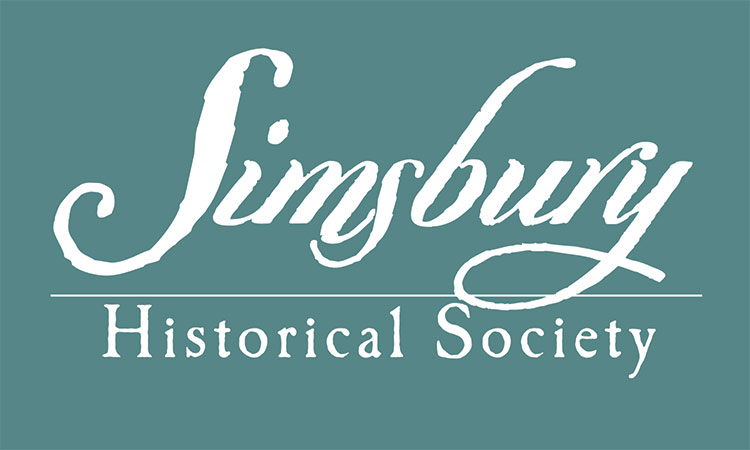
Our Buildings
Ellsworth Visitors Center, 1966 – Simsbury
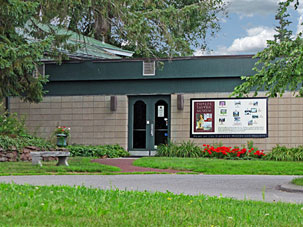
Today the building is called the Visitors Center and houses the Historical Society Research Library and Archive, Museum Store, and rest rooms, and serves as a year-round program space for the Historical Society and greater Simsbury community. Tours of the historic site begin at the Visitors Center; a large exhibition case holds rotating displays of objects from the collection. There is also a play area for young children with historic costumes, a mirror, and wooden toys for hands-on fun.
Phelps Tavern, ca. 1771 – Simsbury
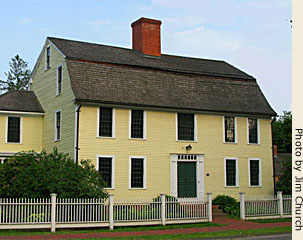
The Phelps house and tavern was owned by five generations of the Phelps family for nearly two hundred years. The building served as family home, canal hotel, lodge meeting site, entertainment hall, and local tavern. From 1786 until 1849, three generations of fathers and sons, and one widow, served as tavern-keepers.
Built for Elisha Phelps in 1771, the house may include part of an earlier “dwelling” constructed by 1761. The building was a family residence until Noah Phelps, Elisha Phelps’ brother, acquired the first tavern license in 1786. His son Noah A. Phelps ran the tavern from around 1805 until his death in 1817. His widow Charlotte operated the tavern herself until her son, Jeffery Phelps, purchased the property in 1820.
Jeffery Phelps ran the tavern for 29 years, closing the business in 1849 to devote himself to agriculture and other interests. The building was remodeled in 1879 and 1915 by resident family members, and remained a family home until it was given to the Simsbury Historical Society in 1962 as a gift by Mary Phelps Ensign Lovejoy. The last family occupants were the family of Mr. and Mrs. Jeffrey O. Phelps, 4th.
Phelps Barn
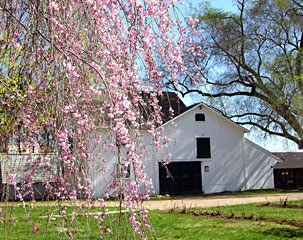
The Phelps Barn is on its original location. It was acquired by the Simsbury Historical Society in 1962 as part of the donation made by Mary (Ensign) Lovejoy, daughter of Joseph and Mary (Phelps) Ensign and granddaughter of Jeffery O. Phelps, II.
Peddler's Wagon, ca. 1869 (inside the barn)
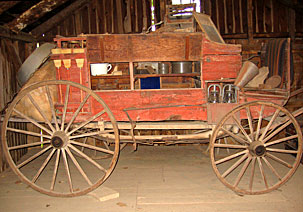 In 1869, Civil War veteran Lucius Wilcox Bigelow (1841-1929) went to Templeton, MA, to purchase three peddler’s wagons for his employer, Gibson and Nellis, of Winsted, CT. Bigelow chose his own wagon from the three and planned a peddler’s route from Winsted through Collinsville, Canton, Avon, Simsbury, and Granby. Peddlers who worked for shop owners usually worked a specific number of months, selling goods provided by their employers. They earned about $30 or $40 each month and bonuses if sales were good.
In 1869, Civil War veteran Lucius Wilcox Bigelow (1841-1929) went to Templeton, MA, to purchase three peddler’s wagons for his employer, Gibson and Nellis, of Winsted, CT. Bigelow chose his own wagon from the three and planned a peddler’s route from Winsted through Collinsville, Canton, Avon, Simsbury, and Granby. Peddlers who worked for shop owners usually worked a specific number of months, selling goods provided by their employers. They earned about $30 or $40 each month and bonuses if sales were good.
Bigelow went into business for himself in 1875, purchasing both horse and wagon. Bigelow sold tin ware, household items, and novelties, and purchased scrap metal and cloth for resale. After 1900, he began buying and selling “antiques,” becoming an active if unknowing participant in the Colonial Revival movement. Called the last Yankee peddler in Connecticut, Bigelow gave up his business in 1925. Ten years later, his widow loaned the still-loaded wagon to the Simsbury Historical Society. In 1954, the Historical Society acquired the wagon as a permanent gift from Mrs. Bigelow’s niece.
Carriage House, ca. 1885-Simsbury
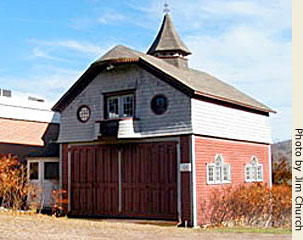
Carriage houses were built to store horse-drawn pleasure vehicles such as carriages and sleighs. Common until the early twentieth century, many also stored vehicle maintenance equipment and accessories. Some included living quarters on an upper floor or adjoining space for household or carriage staff.
Depending upon personal taste or financial status, a carriage house could be very simple or extremely fancy. Many were built according to the design of the main house or current architectural trend.
This fancy carriage house was built for Adelaide Eno Wilcox (1840-1914) probably during the remodeling of her family home, Elmstead, located at 880 Hopmeadow Street. It is an interesting combination of shingle and Queen Anne styles – decorative wood shingles clad the entire building and are not shadowed by deep roof eaves; mixed elements include a cupola, a small double-door balcony, and “Palladian” arched windows.
The carriage house was acquired by the Simsbury Historical Society and moved to its present location in 1969.
Fuse Wagon (inside the carriage house)
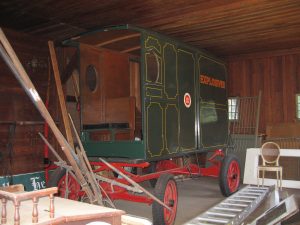 Currently in protective storage in our Carriage House, the Ensign-Bickford Explosives Wagon may be viewed by special appointment. This high-bodied bright green and yellow vehicle was used well into the 20th century to safely carry manufactured fuses from the factory to the rail road for transportation. The Historical Society is actively seeking information about our Fuse Wagon and invites anyone who has pictures of or stories about the wagon to contact us.
Currently in protective storage in our Carriage House, the Ensign-Bickford Explosives Wagon may be viewed by special appointment. This high-bodied bright green and yellow vehicle was used well into the 20th century to safely carry manufactured fuses from the factory to the rail road for transportation. The Historical Society is actively seeking information about our Fuse Wagon and invites anyone who has pictures of or stories about the wagon to contact us.School House, ca. 1790 – Simsbury
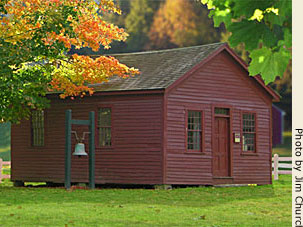
This school was originally located on Tariffville Road in what is now Bloomfield, near the present Old Saint Andrew’s Episcopal Church. At the time, this was an area of Simsbury known as Scotland; the school served Scotland North District pupils in Simsbury until 1843 when the area was annexed to the Town of Bloomfield.
Mary Skinner is the earliest known teacher for this school. She was paid $48 in 1866, probably for teaching a single term of school. In 1873, John P. McKinney was paid 25 cents per week for making the fire in the school. About 15 children ranging in age from 5 to 15 attended this school at the time. Average attendance for a three-month term was only about 30 days.
The building was modified in 1826 and served as a school house until 1933 when it was converted into a single family home. It was acquired by the Simsbury Historical Society and moved to its present location in 1970.
Hopmeadow District School Bell, 1850 - Hartford
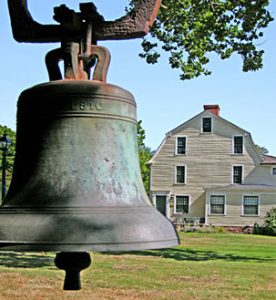 There have been as many as twelve or thirteen school districts in Simsbury reflecting the population settlement and distribution within the town. The first Hopmeadow District School was built about 1739 on the southwest corner of Hopmeadow and Wilcox Streets.
There have been as many as twelve or thirteen school districts in Simsbury reflecting the population settlement and distribution within the town. The first Hopmeadow District School was built about 1739 on the southwest corner of Hopmeadow and Wilcox Streets.
This bell was cast by J(ohn) Doolittle of Hartford, CT, in 1810 for the second Hopmeadow School, constructed in 1799. The school was located on the west side of Hopmeadow Street, south of the present Simsbury Cemetery gate. It was moved north on Hopmeadow Street in 1853 and served Hopmeadow District pupils until it was closed in 1891. The building was used as a private garage until it was torn down in 1976.
Hendrick Cottage, ca. 1795 – Simsbury

The exact age of this charming, gambrel-roofed house has not been determined, but it undoubtedly dates from the 1790s or earlier. Property records indicate that Reverend Timothy Woodbridge acquired the land where the house was later built as early as 1721. By 1795, the property had passed to John Poisson, who contracted Calvin Barber to build a chimney and stone foundation for his “Dwelling House.” It is possible that an earlier building was being modified, but it is more likely that “Hendrick Cottage” dates from 1795.
The property was acquired by Thomas Belden in 1813. His son Horace Belden settled into the house soon after his marriage to Rachel Selina Fowler in 1830. The house remained in the Belden family until 1958 and is named for Fanny Josephine Pomeroy Hendrick the last family member to occupy the building.
Originally located at what is now 25 West Street, Simsbury, Hendrick Cottage was acquired by the Simsbury Historical Society and moved to its present location in 1965.
Probate Building, 1876 – Simsbury
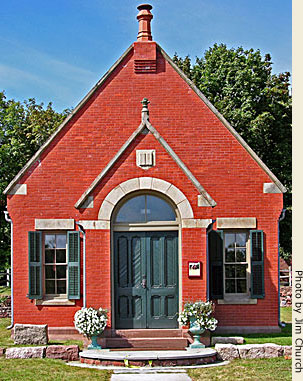
Probate courts hear matters dealing with estates, adoptions, guardianships and name changes. The probate district of Simsbury was established by the General Assembly in May of 1769. The first appointed probate judge of Simsbury was John Owen who served until his death in 1783. Julius Chapman was the first elected probate judge; he served from 1851 until 1855.
This slate-roofed brick building was constructed in 1876 with support from Jeffrey O. Phelps II (1820-1899), a former probate judge. Its primary function was to serve as a vault to safely store probate and town records. The building cost $1,600.00 to build and $33.00 to furnish. Originally located at 7 Wilcox Street, it is a typical and charming Victorian pattern book design. It served Simsbury until 1939 when the probate court was moved to Eno Memorial Hall. Since 2009, the building has served as the headquarters for the Simsbury Land Trust.
The Probate building was acquired by the Simsbury Historical Societyin 1970 and moved to its present location in 1998.
Ice House, 1889 – Simsbury
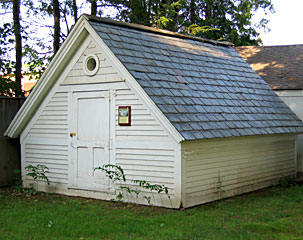
Ice blocks were used in insulated “ice boxes” to keep food cool at home. Dairy farmers used ice to keep butter, cheese and milk fresh for market. Chipped ice was served in drinks or used to make ice cream. Feverish patients were made more comfortable with cool, damp cloths.
This ice house was built in 1889 for Lemuel S. Ellsworth who lived at 740 Hopmeadow Street here in Simsbury. Ice blocks cut from a man-made pond on East Weatogue Street filled this ice house. More than 40 tons of ice were stored here every winter!
The ice house was acquired by the Simsbury Historical Society and moved to its present location in 1969.
Meeting House, 1970 – Simsbury
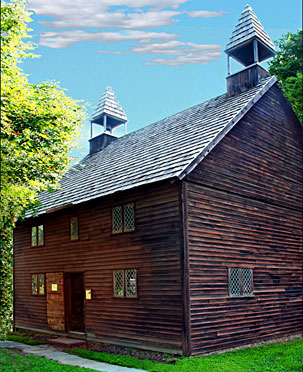
Early New England meetinghouses were used for religious services and town meetings. The first meeting house in Simsbury was built in 1683 on Hopmeadow Street and was located near the present center gate of Simsbury Cemetery. It cost 33 pounds to build and was used until 1739. A monument erected in 1935 marks its site.
Our reproduction meeting house was built in 1970 to serve as the Simsbury Tercentenary Celebration headquarters. The design is based on a 17th century English-style reproduction built in 1935 to celebrate the State of Connecticut Tercentenary. Our reproduction includes several windows and the door of the 1935 structure.
Pillory & Stocks, 1998 - Simsbury
Many early New England towns used pillories and stocks to punish unruly citizens and criminals. A pillory victim was forced to stand with his head and hands thrust out in front and secured by boards. A victim of the stocks was seated and secured by the feet, which were usually left bare even in winter. Both devices date back to the medieval period and were used until the late nineteenth century to inflict public humiliation as well as punishment. Victims were subjected to the extremes of weather as well as verbal abuse from community members, who often threw mud and rotten food at the victims.
There is no evidence that Simsbury used either pillories or stocks, but this fanciful addition to the site delights school children and visitors alike. This pillory and stocks were constructed as an Eagle Scout project in 1998 by Troop 76 of Simsbury.
Ensign-Bickford Exhibition Building, 1966 – Simsbury
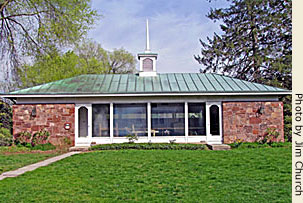
The Ensign-Bickford Company is responsible for the early manufacture and widespread use of the safety fuse in America. Developed in 1831 by Cornishman William Bickford, the Miner’s Safety Fuse was introduced to Farmington Valley mining operations in 1836. Simsbury production began in 1837. Joseph Toy joined the company in 1839 and set up his own manufactory, Toy, Bickford & Company along the Hop Brook in 1851. After Toy’s death in 1887, the company added the name of his son-in-law and successor, Ralph Hart Ensign. This building was constructed in 1966 with native stone from the former Belden Mansion ice house to house the donated Ensign-Bickford Collection of early safety fuse manufacturing equipment.
Guard Booth, ca. 1950 - Simsbury
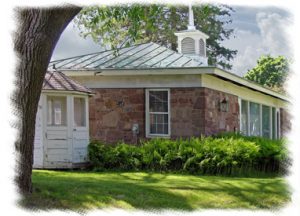 These octagonal guard booths or stations were used at the Ensign-Bickford manufactory site in Simsbury. Because the company handles and produces explosives, Ensign-Bickford maintains strict security measure. Booths such as these were installed at each driveway entrance to the grounds. Uniformed guards checked in anyone who entered or exited the site. During World War II, additional security was employed – armed guards were posted and parts of the grounds were surrounded by fences.
These octagonal guard booths or stations were used at the Ensign-Bickford manufactory site in Simsbury. Because the company handles and produces explosives, Ensign-Bickford maintains strict security measure. Booths such as these were installed at each driveway entrance to the grounds. Uniformed guards checked in anyone who entered or exited the site. During World War II, additional security was employed – armed guards were posted and parts of the grounds were surrounded by fences.
The guards also worked to ensure a safer work environment. Matches were not allowed in the plant area; to be caught with them was grounds for dismissal. Ensign-Bickford employees could deposit their cigarettes and matches with the guards at the beginning of their shifts – or drop them in a box in the wall – and retrieve them at the end of their work-day.
These booths became obsolete as security and safety measures were updated by Ensign-Bickford. The Simsbury Historical Society acquired two of the booths in the early 1970s to enhance its Ensign-Bickford exhibition and archive collection.
Fuse Wagon
 Currently in protective storage in our Carriage House, the Ensign-Bickford Explosives Wagon may be viewed by special appointment. This high-bodied bright green and yellow vehicle was used well into the 20th century to safely carry manufactured fuses from the factory to the rail road for transportation. The Historical Society is actively seeking information about our Fuse Wagon and invites anyone who has pictures of or stories about the wagon to contact us.
Currently in protective storage in our Carriage House, the Ensign-Bickford Explosives Wagon may be viewed by special appointment. This high-bodied bright green and yellow vehicle was used well into the 20th century to safely carry manufactured fuses from the factory to the rail road for transportation. The Historical Society is actively seeking information about our Fuse Wagon and invites anyone who has pictures of or stories about the wagon to contact us.
The Simsbury Historical Society is a non-profit organization that depends upon your support. Please consider making a donation to support our efforts in preserving Simsbury's rich history. If you're interested in becoming a member of the Simsbury Historical Society, please visit our Membership page.
